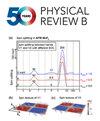Coexistence of antiferromagnetism and ferrimagnetism in adjacent honeycomb layers
IF 3.7
2区 物理与天体物理
Q1 Physics and Astronomy
引用次数: 0
Abstract
Ferro-/ferri- and antiferromagnetically ordered phases are typically exclusive in nature, thus, their coexistence in atomic-scale proximity is expected only in heterostructures. Breaking this paradigm and broadening the range of unconventional magnetic states, we report here on the observation of a new, atomic-scale hybrid spin state. This ordering is stabilized in three-dimensional crystals of the polar antiferromagnet Co2Mo3O8 by magnetic fields applied perpendicular to the Co honeycomb layers and possesses a spontaneous in-plane ferromagnetic moment. Our microscopic spin model, capturing the observed field dependence of the longitudinal and transverse magnetization as well as the magnetoelectric/elastic properties, reveals that this novel spin state is composed of an alternating stacking of antiferromagnetic and ferrimagnetic honeycomb layers. The strong intralayer and the weak interlayer exchange couplings together with competing anisotropies at octahedral and tetrahedral Co sites are identified as the key ingredients to stabilize antiferromagnetic and ferrimagnetic layers in such close proximity. We show that the proper balance of magnetic interactions can extend the stability range of this hybrid phase down to zero magnetic field. The possibility to realize a layer-by-layer stacking of such distinct spin orders via suitable combinations of microscopic interactions opens a new dimension toward the nanoscale engineering of magnetic states.在相邻的蜂窝层中反铁磁性和铁磁性共存
铁-/铁-和反铁磁有序相在本质上是典型的排他性相,因此,它们在原子尺度上的共存只有在异质结构中才有可能。我们打破了这一范式,拓宽了非常规磁态的范围,在这里报告了一种新的原子尺度的杂化自旋态的观察。在极性反铁磁体Co2Mo3O8的三维晶体中,垂直于钴蜂窝层的磁场稳定了这种有序,并具有自发的面内铁磁力矩。我们的微观自旋模型捕捉了观察到的纵向和横向磁化以及磁电/弹性特性的场依赖性,揭示了这种新的自旋状态是由反铁磁和铁磁蜂窝层交替堆叠组成的。层内强和层间弱的交换耦合以及八面体和四面体Co位的各向异性竞争被认为是稳定近距离反铁磁和铁磁层的关键因素。研究表明,适当的磁相互作用平衡可以将混合相的稳定范围扩展到零磁场。通过微观相互作用的适当组合实现这种不同自旋顺序的逐层堆叠的可能性,为磁性态的纳米级工程开辟了一个新的维度。2025年由美国物理学会出版
本文章由计算机程序翻译,如有差异,请以英文原文为准。
求助全文
约1分钟内获得全文
求助全文
来源期刊

Physical Review B
物理-物理:凝聚态物理
CiteScore
6.70
自引率
32.40%
发文量
0
审稿时长
3.0 months
期刊介绍:
Physical Review B (PRB) is the world’s largest dedicated physics journal, publishing approximately 100 new, high-quality papers each week. The most highly cited journal in condensed matter physics, PRB provides outstanding depth and breadth of coverage, combined with unrivaled context and background for ongoing research by scientists worldwide.
PRB covers the full range of condensed matter, materials physics, and related subfields, including:
-Structure and phase transitions
-Ferroelectrics and multiferroics
-Disordered systems and alloys
-Magnetism
-Superconductivity
-Electronic structure, photonics, and metamaterials
-Semiconductors and mesoscopic systems
-Surfaces, nanoscience, and two-dimensional materials
-Topological states of matter
 求助内容:
求助内容: 应助结果提醒方式:
应助结果提醒方式:


